The TTC’s capital plans cover a wide array of projects related to maintenance and enhancement of the transit system. For planning purposes, this is presented with a rolling 15-year window updated year-by-year. For budget purposes, a 10-year version is produced to feed into the City’s rolling plans.
Separate, but related, is the Real Estate Investment Plan which identifies property requirements for many projects. Some of these are well known, some are only at the “what if” stage for possible future inclusion in the capital plan. This raises awareness of potential needs so that property can be protected and acquired if necessary to keep future options open.
Major points in this article include:
- The TTC 15-year capital plan now sits at $38 billion, and even that does not include possible projects such as the Waterfront LRT.
- About two thirds of the capital plan is not funded, in the sense that the source of money to actually pay for projects is unknown. This affects some current projects such as replacement of subway cars that are partly funded, but cannot proceed until the TTC is certain it can pay for the entire contract.
- Bus replacement and electrification plans run out of money in 2025.
- A very large portion of the plan involves renewal and upgrading of subway infrastructure. Focus on the subway threatens to distract from need of the surface system which is essential to the network’s operation.
- The scale of planned spending on system growth and improvement dwarfs the shortfall in the Operating Budget that will lead to service cuts in 2023. There is no reconciliation of the parsimony of the operating plans for transit service with the scope of capital plans for expansion and improvement.
- Some future funding included in the budget assumes continuation of existing streams from other governments. This is not guaranteed.
- Absent new funding, the State of Good Repair backlog is projected to rise to over $6 billion in the coming decade.
- There is a growing problem that the TTC owns buses, streetcars and subway trains it cannot afford to operate.
When the TTC first unveiled its 15-year Capital Investment Plan in 2019, this was a great shock to the City thanks to a major change in the content. In prior years, only the 10-year budget was produced, and many potential and necessary projects were either shown as “below the line” (unfunded), or were completely omitted. Every year brought big surprises when previously unbudgeted projects had to be acknowledged and started. The 15-year version shows everything including a mountain of unfunded proposals amounting to two-thirds of the total.
At one time, the “below the line” items were treated as a wish list, projects that would be nice to have if Santa Claus appeared one day with bags of transit cash. However, the unfunded portion of the plan now includes much work that is ongoing “State of Good Repair”. Failure to fund and undertake this work will inevitably lead to a decline in the condition of capital assets and transit service. Later in this article there is a chart showing the accumulating SOGR backlog if more funding is not found.
In turn, this changes the relationship between the TTC, City, Provincial and Federal governments. Where much lobbying focused on megaprojects such as new lines or fleet replacement, there is a major shortfall just to maintain the system we already have. Such costs are not “one time” affairs where the pols get together with their silver shovels for a photo op and exchanges of oversize cheques, but rather an ongoing need for investment in basics like vehicle replacement and infrastructure maintenance.
“Ongoing” is not a word government partners want to hear because they prefer single commitments that can be paid out of spare change, as and when it is available, but on a time limited basis.
2022 Priorities
The table below shows the key requests flagged in the 2022 budget. This list was not fully funded, and some items have slipped into 2023 where they will compete with basic maintenance work such as for attention. For clarity, the full amounts were not required in 2022, but the multi-year commitment to many projects is required before they can be launched (for example, purchasing a new subway fleet).

The Fifteen Year Plan
The fifteen year plan now sits at $38 billion. This does not include any major expansion projects because these have been taken over by the province (Ontario Line, Scarborough and Yonge North subway extensions, Eglinton and Finch LRTs). In the charts below, the unfunded portion of each category is shown in paler colours.
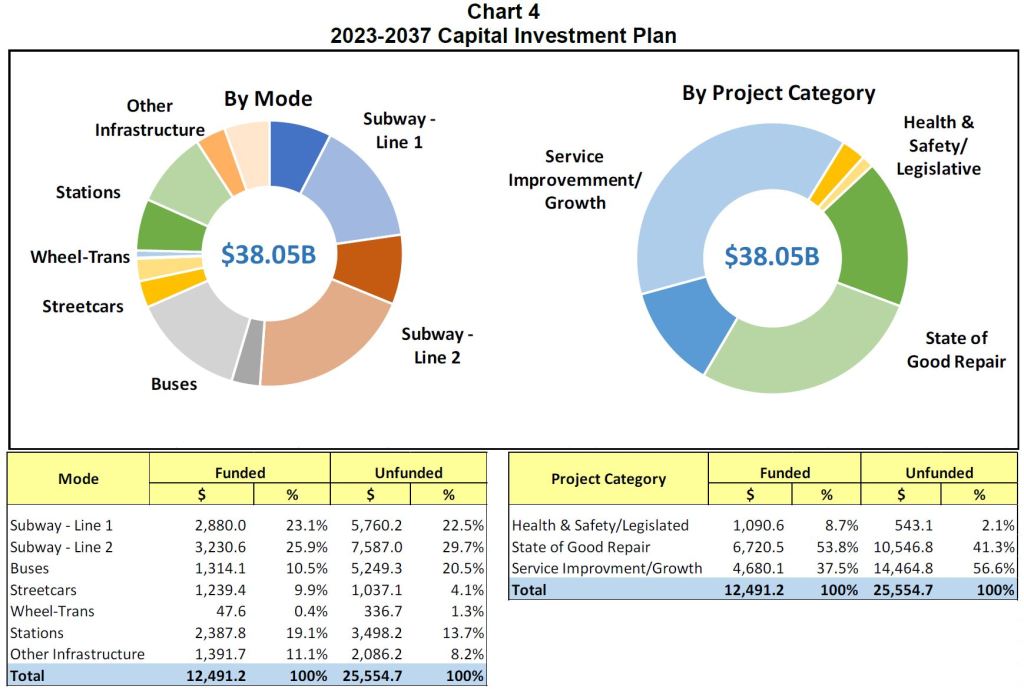
Looking at the plan another way with the unfunded portion broken out shows how deep the hole is. Well over half of the total is for subway work, primarily the capacity enhancement and renewal programs for Lines 1 and 2 (Yonge-University-Spadina and Bloor-Danforth), as well as for station upgrades and maintenance. This vividly demonstrates how expensive subways are to own, especially as they age.
A related problem is that subways get disproportionate attention both because of the dollars involved and the number of riders served. It is easy for projects on the surface system, which is vital to the overall network, to be shunted aside.
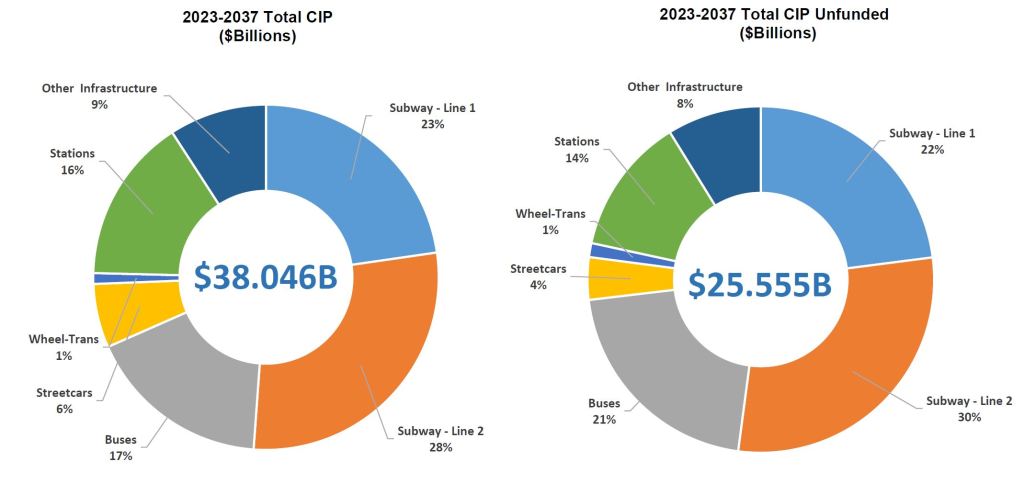
The next chart shows how the various funding sources, to the extent they are known, change over the 15-year span. Development charges (yellow) disappear after 2027 because the current bylaw that sets them will expire. Even the amount shown for 2023-2027 assumes that Ontario will keep its word and replace any loss in DC revenue triggered by provincial changes in DC rules. “Making whole” the City is all well in theory, but this becomes one more spending area that would compete with any new requests, notably to address the unfunded portion of the budget.
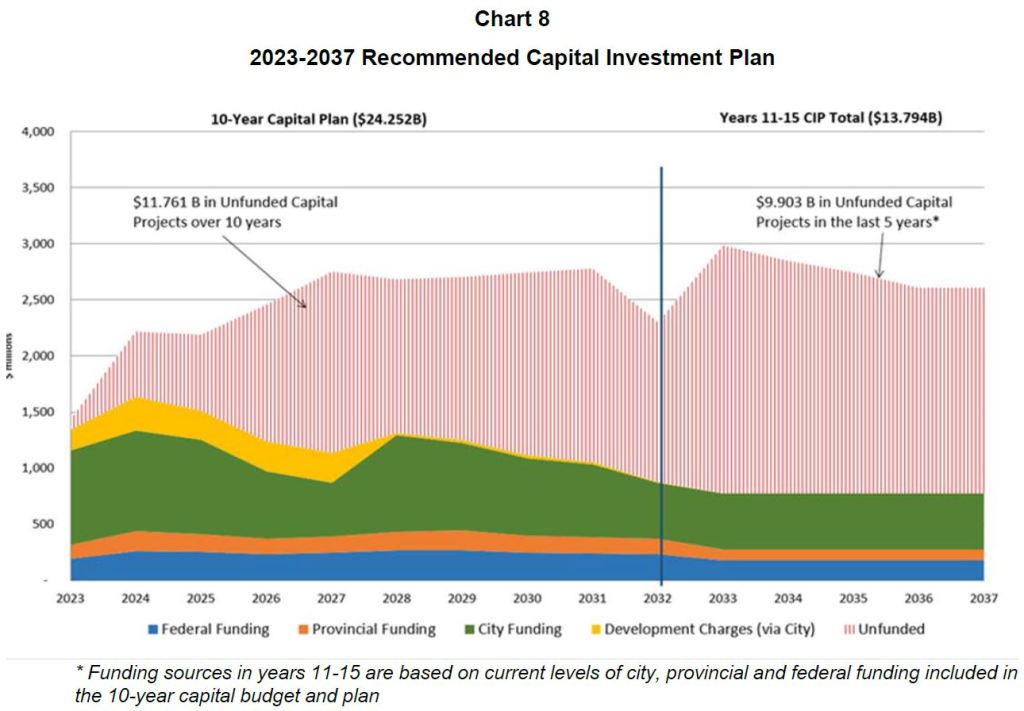
Table 13 breaks down the additional funding needs by year and major project area. This shows a familiar pattern where the amount in the current year, 2023, is small but future years present a big problem. That growth used to have padding with the crisis conveniently a few years away, but that is no longer the case.
Although the plan includes provision for design of the Waterfront East LRT expansion, there is nothing listed for construction. Similarly, expansion at Exhibition Place (the link from Exhibition to Dufferin Loop) and further west to The Queensway is not included in this plan.
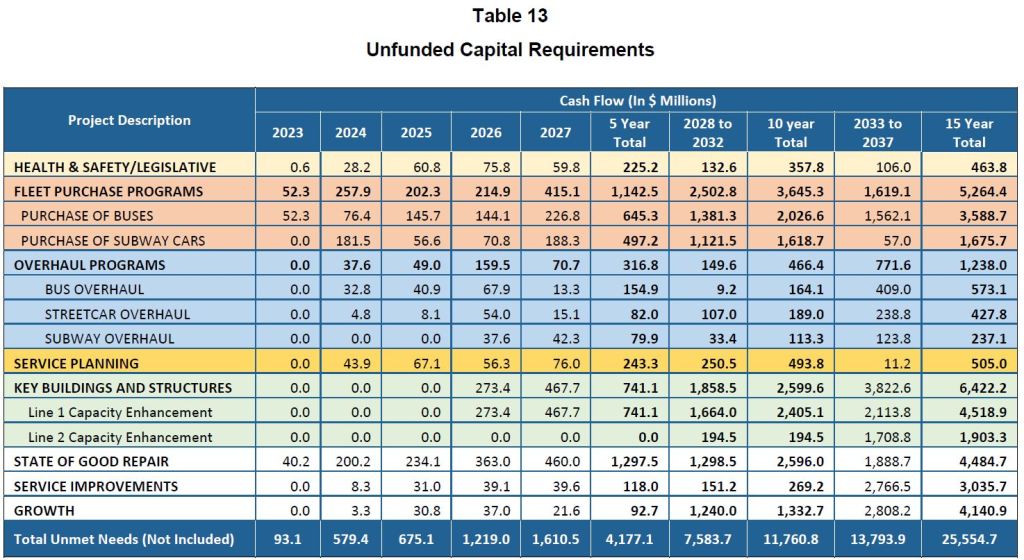

The Ten Year Budget
Unlike the 15-year plan, the 10-year budget is based on funding the TTC has some expectation of receiving although the cheque is not exactly “in the mail” for some of this.
There is an obvious contrast between this Capital Budget, of which over a third is earmarked for “Growth” and “Service Improvement” at a time when retrenchment in day-to-day service is proposed by the Operating Budget. There is a further $11.8 billion in unfunded requirements over the 10-year period as shown in the table above which includes $5 billion for growth and service improvement.
There is a something askew when overall budgets seek more money for capital to expand the capability for more service than the shortfall in day-to-day operations which starve for funds, and state of good repair falls further and further behind. (Click on any item to open the charts in a gallery.)

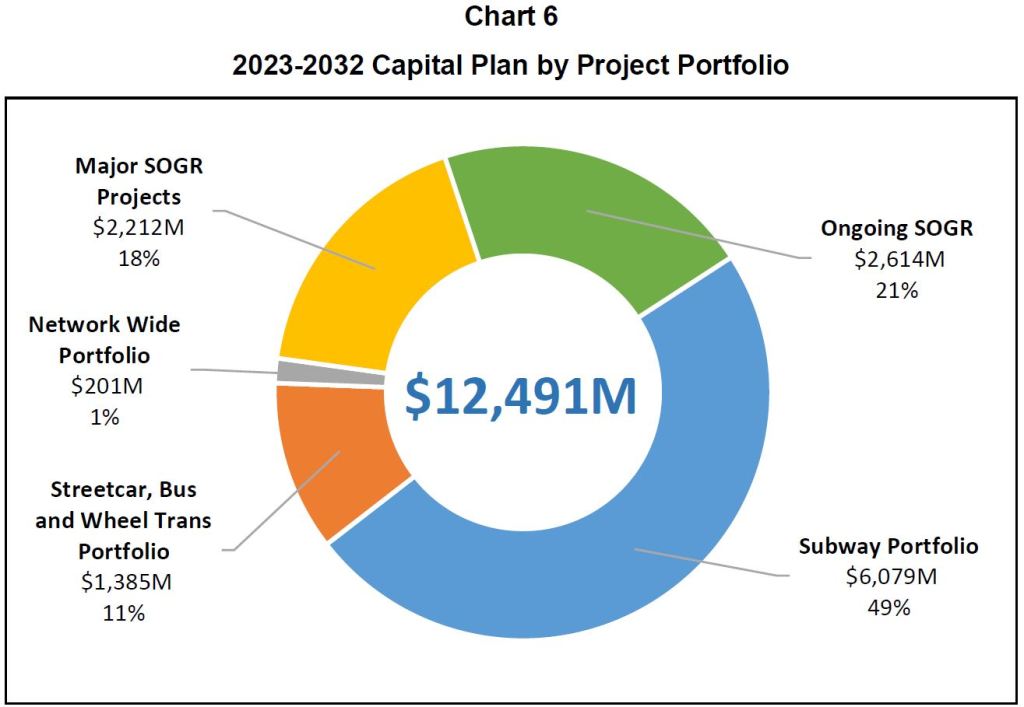
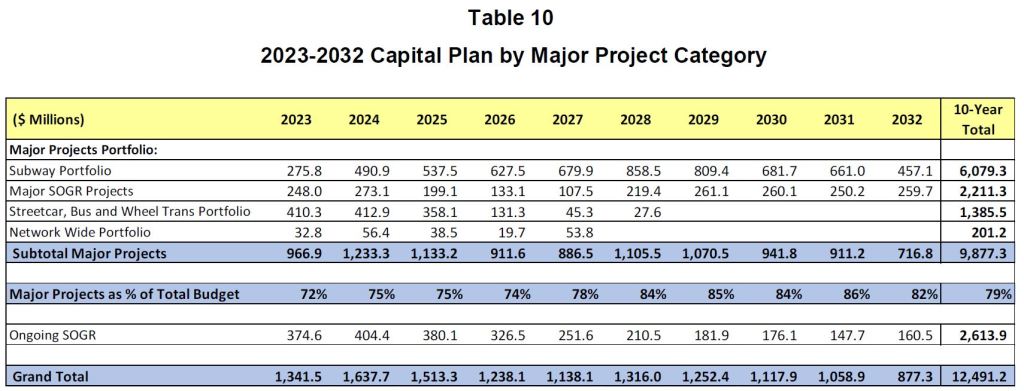

The funding summary below shows where the TTC expects to get $12.5 billion over the next ten years.
- Provincial gas tax is assumed to sit at a steady level with no growth. The implication is that this source will at best remain fixed through the effect of fuel efficiency changes and the shift to electric vehicles.
- PTIF (Public Transit Infrastructure Fund) moneys from Ontario and Canada are entirely consumed by the Bloor-Yonge Station expansion project.
- TTC Depreciation is charged on assets that are not considered eligible for subsidy. This is a dwindling source of capital funding as the proportion of such assets still on the TTC’s books falls. Depreciation is charged against the Operating budget.
- Development Charges, as noted earlier, only extend at a high level to 2027, and depend on Ontario “making whole” the City for losses in this revenue stream caused by provincially legislated changes.
- The City Building Fund is an additional property tax levy brought in by Mayor Tory to fund housing and transit projects.
- The TYSSE (Spadina-Vaughan extension) project is still open as a budget item because of claims and property matters that are not yet settled.
Not included here is the provincial spending on its own projects through Metrolinx that rivals the TTC’s budget in size. The difference between the two is that provincial expenses are very substantially for expansion and growth, while the TTC faces large capital maintenance costs.
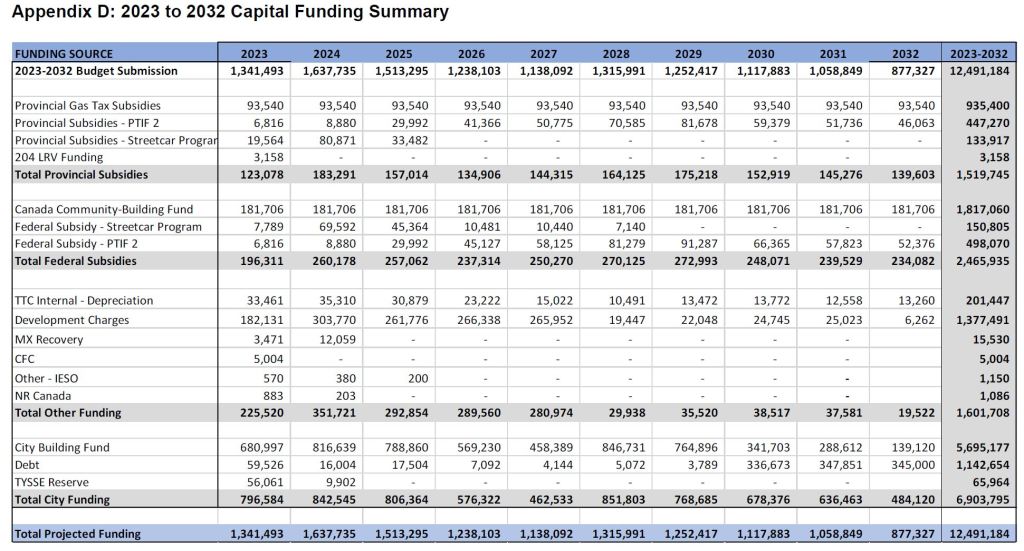
Major Projects Detail
The 10-year budget is subdivided into major projects in the table below. Note that some of these lines have many sub-projects but the breakdown for them has not yet been published. These are the so-called “blue pages” and “blue books” which show the detailed spending and project descriptions. (Click on either page to open in a gallery.)

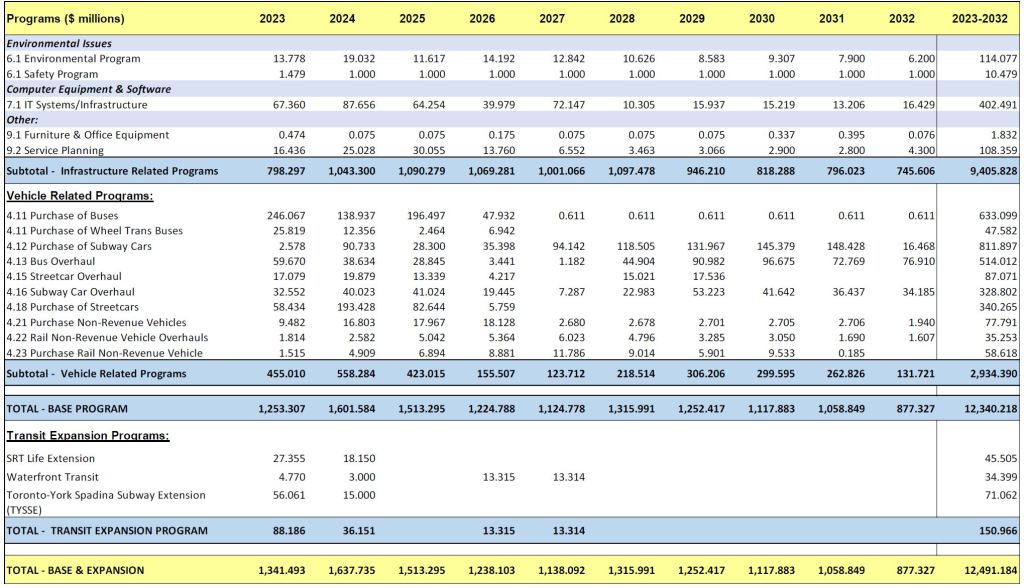
State of Good Repair Backlog
The shortfall in capital funding has an inevitable effect on the ongoing state of good repair on the system. Work that is deferred represents infrastructure and systems that have reached the point where major overhaul or replacement is required.
A favourite myth among subway advocates holds that these facilities last for a century. That is not true, and every aspect of a subway system: tunnels, track, ventillation, drainage, stations, escalators, elevators, trains, electrical and signal systems all wear out over time.
A problem facing Toronto is that some of the future costs will be charged by the province to recover ongoing costs of its projects. Putting off the spending will not be an option when a senior government with the power to withhold subsidies calls for payment. In turn, this could force further retrenchment in spending on “Toronto” assets while we fully fund “Provincial” ones.

Bus Fleet Plans
The Bus Fleet Plan is touted as an example of how the TTC will contribute to emission reductions in the City, but it is symptomatic of other problems. First and most obvious is the lack of funding beyond 2024. Note also that this chart only shows the vehicle component, and additional spending will be needed to convert garages from diesel to electric operation.
The second problem, not so obvious here, is the overall fleet size and level of service that will be possible assuming that this new fleet comes to be. Although the City has aggressive plans for overall emission reduction, this does not yet include a massive increase in transit operations and shifting trips from autos to transit.
The third problem is that the ongoing cost of bus replacement is driven up both by the higher cost of electric vehicles and the ongoing shift in vehicle retention from 18 to 12 years. The latter is quite ironic considering that a major advantage of electric transit vehicles is their longevity as we know from the subway and streetcar fleets, and once saw in the trolleybus fleet.
The decision to retain buses for only 12 years was taken when the fleet was all diesel or diesel-hybrid. As the fleet of electric buses grows across the transit industry, we will see whether their longevity can grow beyond diesel standards. A major problem here is that the eBus technology is new, and there is likely to be obsolescence in the early years that will work against longer-term retention.
A final problem for the TTC is that its fleet is currently much larger than its peak service needs with a spare factor of over 30% compared to an industry norm of 20%. As of October 2022, the TTC listed 2056 active buses in the fleet while the peak service was only 1514, a spare factor of 36% (for every 100 buses in peak service, 36 more were in the garage).
This means that buses are available for service, and will continue to be replaced under the fleet plan, even though the TTC does not have funding or staff to operate and maintain them. About 200 more buses could be operated in peak periods with the existing fleet at a spare factor of 20%.
The TTC needs a multi-year plan for all of its fleets based on projections for ridership recovery and growth, combined with any emission reduction plans that transit will aid.
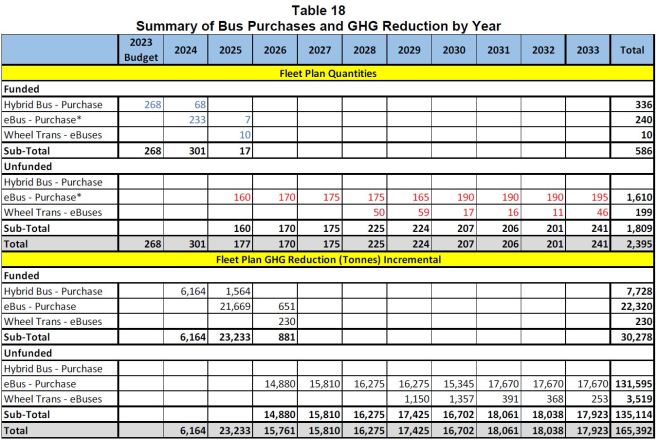
Details of Major Project Groups
The tables below list the components of major groups of projects within the budget including their cost and the degree to which they are funded (or not).
For Line 1 Yonge-University-Spadina, this includes additional trains and a new storage yard in York Region as part of the Yonge North Extension.
For Line 2 Bloor-Danforth, this includes new trains to replace the existing fleet plus provision for the Scarborough extension and demand growth. Also included in the longer term is a new yard at Kipling on the former CPR Obico Yard property. More frequent service on Line 2 will only be possible with a conversion to Automatic Train Control, and upgrades to the traction power system.
For the bus fleet, the major item is vehicle replacement (as discussed above), but also later in the 2020s the construction of a new garage on Kipling Avenue. This would be the first all-electric garage built by the TTC.
On the streetcar system, there are 60 new cars to be delivered through the early 2020s, although like the bus system, the question remains of whether there will be funding to operate and maintain them.
Within the Stations category, the two major items are the Bloor-Yonge project and Platform Edge Doors, now estimated at a cost of $2.868 billion, none of which is funded.
Overall, there will be difficult challenges in prioritizing these projects for funding, and many decisions will depend on what we assume as the future for transit within Toronto – recovery and growth, or gradual decline.
(Click on any page to open in a gallery.)







The Real Estate Investment Plan
The TTC has many needs for real estate of various types: office space, industrial space for maintenance works, rights-of-way for system expansion. The TTC also owns much land whose usage might be intensified as part of the City’s housing strategy, notably lands along the open (or lightly covered) subway rights-of-way and parking lots.
The Real Estate Investment Plan catalogues many items with the intent of flagging both current needs and future possibilities that should be addressed early in system planning.
The full list is in Appendix B of the Capital Budget report. Here are some highlights. The further these projects are shown in the future, the less certain are their dates.
- The current office building at 1900 Yonge Street is too small for TTC needs, and they occupy much leased space in nearby (and not so nearby) buildings. The intent is to find, in partnership with the City’s office space consolidation program, a replacement for the existing offices. The plan shows a transfer of the McBrien Building to the City in 2028 after which the Davisville site can be redeveloped.
- Many functions within the TTC operate out of trailers and storage containers. These may be suitable for short term offices at project sites, but not for the long term. Replacing these is another part of the office consolidation project.
- Evaluation of existing bus garages for conversion to electric buses is ongoing, along with consideration of whether any capacity expansion is possible.
- A possible Wheel-Trans garage location adjacent to Queensway Garage on Evans Avenue.
- Expansion and upgrades at Wilson and Davisville Yards.
- Western Yard (Obico lands) access from the existing Line 2 subway. The westward extension of Line 2 itself is listed for 2041 which is likely a placeholder date.
- A property at 800 Kipling Avenue will become a 10th bus garage site in the 2030s. The timing of this project would depend on the rate of growth of the bus fleet.
- Both 800 Kipling and the Western Yard lands will be used to consolidate from other sites in the interim.
- A new, expanded control centre will be built to replace the Gunn Building in the Hillcrest Complex. This will include a new data centre to replace existing installations including at 1900 Yonge.
- New loops are planned for the Broadview Station expansion (2023), Park Lawn GO (2026), and the Exhibition extension to Dufferin Loop (2027).
- Further possibilities include an interim bus loop in the Port Lands (2024), Pape/Carlaw Ontario Line interchange (2027), Polson Loop (south end of the Cherry extension, 2029), Broadview Avenue south extension (2030) and Queen-Broadview (2030).
- Various property requirements for the Waterfront East LRT are listed for the late 2020s and early 2030s.
- Subway station expansions are listed for King concourse (2029), St. George (2037) and St. Andrew second exit (2037).

As much as it is/was deemed essential, I’ve always questioned the massive cost and return per investment of the Yonge-Bloor platform widening and the realignment of track to achieve it. It would be very nice to have, but perhaps it’s time to re-examine it with the latest drop in ridership, and how the same investment elsewhere, as in GO rail from the northern regions, would render far more gain per investment and relieve the Yonge Line altogether of being overwhelmed, not just Y-B alone.
As to why this loading from outside Toronto was ever dumped onto the TTC in first place without the funding to go with it is an essential question?
I know the answer, but it’s not acceptable. Hillcrest must learn to say “NO!” (unless provincial funding for it is made)
Steve: There is a general problem that the province is happy to build stuff that Toronto must then operate and take the consequences for, of which the Yonge North line is only one example.
A clarification: There is no track realignment at Bloor-Yonge, only a new eastbound platform.
LikeLiked by 1 person
Hi Steve,
I find it funny that the TTC is proposing a “possible Wheel-Trans garage location adjacent to Queensway Garage on Evans Avenue” when they have been slowly chipping away at the number of Wheel Trans buses on the road by reducing community bus route service and promoting the family of services program. The TTC has already contracted out the Wheel Trans call center. I wouldn’t be surprised if they contact out the entire wheel trans contract over to the taxi sedan companies in the coming years.
LikeLike
If Kipling Garage will be the 10th bus garage, what is the 9th?
Steve: Arrow, Birchmount, Eglinton, Lake Shore (WT), Malvern, McNicoll, Mount Dennis, Queensway, Wilson
LikeLike
It appears as though the proposed new Line 2 yard and bus garage are located on adjacent properties. I wonder if the plan is to build it similar to Wilson Complex with a shared building for the subway and bus division offices.
Also, Queensway Bus Garage is not too far from the proposed new garage. I wonder if they will consolidate Queensway with the new garage and use the existing Queensway garage property for another use, whether it be for the Wheel-Trans or maybe even the non-revenue fleet.
LikeLiked by 1 person
This Bloor-Yonge expansion seems like a huge waste of money…
We could build and entire LRT/short subway line with that😭
What’s your opinion on it, Steve?
Steve: The Bloor-Yonge project is necessary to deal with platform crowding on the Bloor (Line 2) platform, but it is a very expensive undertaking. Although we are sitting in a period of lower demand due to WFH, we cannot assume that this will last forever. A key problem lies in proposed capacity increase on Line 1 through ATC capabilities that will deliver riders to this transfer point at a considerably faster rate than they can be carried away by Line 2. Part of the capacity crunch also lies in the platform space which inadequate to holding riders if there is any delay on Line 2. Much of the focus has been upstairs on Line 1’s southbound platform, but the larger expansion is actually on Line 2.
LikeLike
When the shift to electric cars will fully happen for personal autos will the province have to enact an additional tax on electricity rates so that they can receive the same revenue that they currently get from gas tax?
LikeLiked by 1 person
Steve.
I am slightly out of the loop right now on deep stuff in TTC, due some life changes & my retirement from full time Transit Accessibility Advocate work.
I have tried to study the charts & full report, as usual it’s a daunting experience, simply due to screenreader accessibility still being a sick joke.
I only see 2 very short mentions of the Easier Access III, program.
I still see no work being started at the 2 biggest projects, Islington & Warden stations.
I also notice on a regular basis, on the subway train car maps, that they have not had updated accessibility information in at least 3yrs.
(Most maps & app accessibility information for that matter are severely out of date.)
If we can’t even make the most basic accessibility information reliable & up to date, it’s a extreme disservice to the exact community that the TTC is forcing off WHEELTRANS, those with some ability to use the conventional system..
FOS, is a sad joke, especially with the recent atracks on disabled people on the system & lack of proper training of new operators in the last 4yrs.. (I’ll keep that nasty nugget, for another day)
We have recently elected people to the Toronto City Council, who do not see accessibility as a priority, on the TTC, especially certain members of the TTC Board.
With the budget constraints, are we ever going to actually make the TTC FULLY ACCESSIBLE?
I don’t think so, nor do many in the Accessibility Advocate space in Toronto.
I think that with recent departures at the TTC, this issue is only going to get worse.
Keep up the great work you do Steve, I’ll still be there, albeit not at the meetings in person, very often.
Emily Daigle
LikeLike
The city has to give thought how transit affects new immigrants. New immigrants in Toronto is the place to stay (at least in intial years) because they can’t buy cars, and most find jobs that are in person not WFH. Now with bad service people will think that if the transit is anyways as bad as other GTA cities then why not start there instead?
LikeLike
Hi Steve,
Could you please do an analysis of the 996 route extension to Ellesmere? Today is only the first day but it seems that a lot of the 995 & 996 buses are running in pairs. Many trips are scheduled to depart at the exact same times or by 1-2 minutes apart…so much for blending service. Dwell times for the 996 buses at York Mills station haven’t reduced by much given that the 996 schedules are overly padded.
Also, I noticed that the last 996 from Humber is now just after 6:00pm (it was formerly 7:00pm and even that 7:00pm trip was crowded sometimes) and there’s two scheduled 996S short turn trips at the end of AM rush hour that go from Ellesmere station only up to Wilson station and then deadhead to Arrow Rd. I’m surprised that they don’t go to Jane & Wilson, or even Clayson & Wilson.
Steve: I am planning to do this after the services have been running for a month or two.
LikeLike
This year was supposed to be the year we finally get funding for a new fleet, and since the year has just begun, it seemed like there was still hope. But since there was “$1.7B required in 2022”, which has now passed, and now the project “will continue beyond the 15-year horizon”, things are not looking good at all.
So now it’s official, we’re not going to see any new trains for at least 10–15 years and will be stuck with the old ones for at least another 15–20, and it’s far too late to do anything about it? At this point, is there any chance whatsoever that the first of the new trains will arrive in 2027 like they’re supposed to? I seriously don’t understand why the delay/reluctance of the governments to set aside the required funding, almost seems like a deliberate effort to sabotage the project at this point, given that this is the exact same roadblock we keep running into every few months.
Steve: The TTC is still pursuing the provincial and federal governments for money for the trains. The drop dead date, as I understand it, for placing the order is late 2023. Given Rick Leary’s previous attempts to pursue a rebuild program for the T-1s, yes, I cannot help getting a sense that the new trains don’t have the commitment they deserve.
I’m guessing there’s also 0% chance to have the OL/SSE/YNSE open in 2030 as planned? I also noticed mention of an SRT life extension, which had me wondering whether it will indeed shut down at the end of this year, or will be delayed just like everything else.
Steve: The SRT Life Extension refers to keeping it operating until November 2023. After that, it becomes a bus shuttle. That’s in the budget.
LikeLike
Steve, I rode the 996 extension today and I must say it was finally good to see some consistent service on York Mills. I was checking GPS times and the 996 was running mostly on time even though it has extremely long routing, the 95 ops and managers could learn a thing or two…
Also, the Arrow Rd. drivers are much more skilled than any driver on the 95, much props to them!
LikeLike
TTC is really bad at communicating the proper schedule on their website. The last eastbound full trip 996 does depart at Humber College around 6pm towards Ellesmere Station as stated on the website schedule. However there are 996S trips towards Wilson Station continuing every 10 minutes to 7pm. The same is true for westbound 996S from Ellesmere Station towards Wilson Station every 10 minutes between 7pm and 8pm providing new express service since the 995 is done by then. We wonder why TTC don’t include these trips on their website schedule.
LikeLike
If the order is not placed this year, is it still possible for it to be placed in the coming years, with an equivalent lag in delivery (i.e. if the order is placed in 2024, deliveries would be pushed to 2028 instead of 2027, etc)? Or is deferral by over a decade the only possibility?
Steve: The question here is how long a bid from Alstom that assumes manufacture at Thunder Bay stays valid, and how long that plant stays operational in the absence of major new orders. Conversely, if some other manufacturer has a strong bid, the Thunder Bay political link disappears, and which politician wants to be held account for that?
Makes one wonder what his reasons were for being so adamant on pushing for the rebuild, other than perhaps his own nostalgia for them.
Steve: First, at the time, Leary was not a fan of ATC and a rebuild would leave the ATC question for Line 2 way into the future. However, after seeing the benefits on Line 1, he has changed his tune, and new trains are a pre-requisite to ATC installation on Line 2. Another problem is that if all we do is rebuild the T1 fleet, we still need some additional trains in order to run full service to the SSE, as well as more trains for Line 1. Those orders would piggy-back on a T1 replacement order. You have to look at the history of the rebuild-replace-rebuild-replace debate over the long period of history.
LikeLike
While Alstom obviously has a leg up, does the political link to Thunder Bay effectively disqualify the other manufacturers even if they end up winning the bid?
Steve: This situation is similar to what we faced with the streetcar order, with the additional important point that the specs for the new subway cars are clearly derived from the existing TR fleet. Building “more of the same” is a clear advantage to the incumbent supplier. The greater worry is whether the federal or provincial governments drag their heels on subsidies if they would not represent substantial work within Ontario.
To clarify, installing ATC on the T1s is not on the table regardless of whether they get rebuilt or replaced? I know it would be expensive to do so, and has been previously considered & rejected, but if they end up having to rebuild them while moving forward with installing ATC on line 2, it seems like they wouldn’t have a choice. Then again, considering ATC work on line 1 has been going on since 2011, and line 2 has barely even started (if at all), by the time line 2 ATC is ready the T1s might be up for retirement anyway, rebuilt or not. At least the new trains would be able to run without ATC while it isn’t ready.
Steve: Retrofitting ATC to the T1s really isn’t an option, but a life extension program would take that fleet well beyond the ATC timeframe for Line 2. We also have the ridiculous situation on the SSE that Metrolinx plans to install an interim block signal system pending ATC capability on the Line 2 fleet. Obviously this would not be needed if the new fleet gets here before the 2030-ish opening date.
While piggy-backing the orders is the obvious thing to do, if they won’t be able to place the T1 replacement order, would they still place a small order for service expansion?
Steve: Yes, but that isn’t funded yet either. Also, of course, the need depends on whether you believe that ridership will actually return. At some point, if we make a decision to plan for a lower riding level (say 80% of pre-pandemic as a base), we could box ourselves in on future capacity.
LikeLike
The TTC presentation to the City’s Budget Committee is available.
Steve: I didn’t report on it because there really is nothing new compared to the TTC Board presentation, only some reformatting. The most interesting comment in the Budget meeting was that the details of the March changes will be available in draft in about a week. I will review them here with the caveat that they will likely change before implementation.
LikeLike